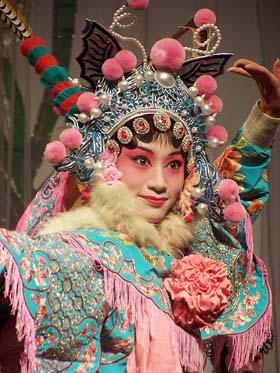Performing Art Model of Kunqu
2009-06-25 21:38 BJT
In the performance of Kunqu, refinement and rigor are emphasized.
A standard Kunqu scenario is very intricate. A Kunqu program not only details the arrangements of acts, verses, and the names of tunes to which verses are set, but also defines the roles, stage settings, costumes, props, and performers' movements, even going so far as to explain the significance of the position performers take on stage.
The roles of Kunqu are broadly divided into seven categories, including sheng (male roles), dan (female roles), jing (painted face), mo (middle-aged male roles), chou (clowns), wai, and tie, and each category has further subdivisions. For instance, the sheng roles have laosheng (aged male roles), wusheng (male warriors), and xiaosheng (young male roles), each of which are further divided according to the characters' prominence within the play. The xiaosheng -- young male role -- is divided into daguansheng (big hat role), xiaoguansheng (small hat role), jinsheng (kerchief role), qiongsheng (pauper role) and zhiweisheng (a warrior whose helmet decorated by a pheasant tail feather). The dan roles are divided into six sub-categories.
The Kunqu style of stage makeup is mainly used for jing and chou roles, and occasionally for sheng and dan roles. The three predominant colors being red, white and black. The shades of blue, green, purple and gold are used to portray forest brigands, or ghosts and demons. As in Peking Opera, the color red represents loyalty and justice, black conveys uprightness and straightforwardness, white signifies cunning and shrewdness, and yellow indicates a fierce, tough character. Most of the patterns and techniques of Peking Opera facial makeup evolved from Kunqu, and some were just copied from it.
 |
The most prominent characteristic of Kunqu performance is its lyricism, where the posture of each role is in a dancing mode. Almost all traditional Chinese drama has elements of dance, and in some plays dances have been added, but these are unlike Kunqu, where every physical movement from beginning to end is in the mode of dance, thus creating a complete scope of performance technique.
Mei Lanfang, a great master of Peking Opera, also learned Kunqu, and had a deep understanding of both. He said, "In Peking Opera, postures are relatively unrehearsed, with no structured choreography, but Kunqu is quite different in this respect. The performer match specific postures to each aria. Kunqu truly integrates singing and dancing into each individual performance, with equal emphasis on singing and acting. Performing Kunqu is particularly demanding because the actor is, in effect, dancing from beginning to end."
Kunqu dance is divided into two categories. One is mime, used to interpret to the audience the verses the performer sings; the other is lyrical, to describe scenery, the characters' situation, and their emotions.
One zhezixi (opera highlight), "Zhaojun Leaves the Pass," tells of Wang Zhaojun, a beauty at the Han Dynasty imperial court, on her way to marry the Xiongnu Khan, in order to cement relations with the rulers of ethnic minorities in the border regions. The drama describes Zhaojun's complex emotions and the hardships of the journey. On stage, Zhaojun sings while dancing, and her attendant turns somersaults throughout the performance, which is why this drama is seldom performed, because few performers are able to fulfill its demands.
Plays in this genre are not only taxing for the performers, but also for the audience, since the lyrics are difficult to understand, and the singing is slow and drawn out -- a challenge to concentration and patience. In addition, a drama is generally quite long. In June, 2001, "The Peony Pavilion" was performed in Berlin, Germany, and lasted 19 hours. The local newspaper dubbed it as "a drama marathon." It is rare to see a full performance of this play at one sitting. Usually only a few acts are performed, each lasting 30 to 40 minutes.
Editor: Zhao Yanchen | Source: CCTV.com
 Mail
Mail Share
Share Print
Print


 Video
Video









 2009 China Central Television. All Rights Reserved
2009 China Central Television. All Rights Reserved